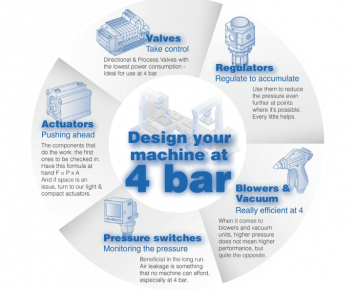- Home » Editorial » Pneumatics
Helping OEMs develop energy-efficient machines

One challenge that could arise is that of space. What if a cylinder with a larger bore will not physically fit with your designated design space? Here, scrutiny is required to select a supplier that can provide compact and lightweight actuator solutions.
The other option is to use a different technology, such as a double-force cylinder. Again, tapping into the expertise of a reputable pneumatics supplier will prove useful in specifying the optimal solution.
Valves: take control
It’s not really high or low pressure that controls actuator speed, but the flow of air it receives. If you need higher speed; the valve will control that for you. With the cylinder bore and force defined, it’s possible to select the valve size.
Blowers and vacuum units
When it comes to blowers and vacuum units, higher pressure does not mean higher performance, but quite the opposite, which is why a product like a high-efficiency nozzle has the potential to deliver notable gains. This solution can maximise air blow efficiency thanks to a more focused blowing impact. Indeed, governed by the Bernoulli Effect, you can improve air blow thrust by 10%.
We saw this in action at a customer producing liquid detergent. The company’s bottle un-scrambler machine housed 25 air nozzles from an SMC competitor, costing €22,441 in annual air consumption. After application analysis we recommended that the customer adopt our high-efficiency nozzles. These products could provide the same blowing performance (flow and impact force), but with a lower nozzle diameter - thus allowing lower inlet pressure. Reduced air consumption led to savings of €6,183 a year, delivering amortisation in just 1.57 months. Performing the same replacement process on six further lines led to total annual savings of €37,098.
My company’s commitment to 4 bar is also visible with our vacuum units, which actually function at their best (maximum efficiency) when using low operating pressure. At 4 bar, we ensure the vacuum pressure necessary to hold the component or product securely. Beyond this pressure, air (and money) is simply wasted and the vacuum unit loses efficiency. By turning up the pressure, you are not getting more force or speed, just more inefficiency.
Regulate to accumulate
As regulators handle point-of-use pressure they can be good collaborators in the 4 bar journey, largely because we can use them to reduce the pressure even further at points where it’s possible. This might include air blow or vacuum applications, endowing the machine with even more energy efficiency. Every little helps
Monitoring the pressure
Although a pressure switch plays no direct role in the 4 bar concept, it can prove beneficial in the long run. For instance, when designing a machine for 4 bar, you need to monitor pressure as the margin is low. In the first instance, pressure monitoring acts as a control measure for the machine to receive the 4 bar it needs. Secondly, pressure switches can monitor air consumption and identify any pressure losses. Air leakage is something that no machine can afford, especially at 4 bar.
The 4 bar future
OEMs should propose that end users adopt machinery which operates at 4 bar in order to stay competitive. Through early project engagement with companies such as SMC, providing the correct sizing for each pneumatic component is possible and ensures it consumes less energy without compromising machine performance. In addition, we can deliver solutions with minimal impact on surrounding or connecting components, thus avoiding any unnecessary time and cost for redesigns. Retrofit projects also benefit from this approach.
https://www.linkedin.com/company/smc-nederland/
-
SMART Manufacturing & Engineering Week
04 - 05 June, 2025
NEC, Birmingham UK -
PPMA 2025
23 September, 2025, 9:30 - 25 September, 2025, 16:00
NEC, Birmingham UK -
Advanced Engineering Show 2025
29 October, 2025, 9:00 - 30 October, 2025, 16:00
NEC, Birmingham UK










